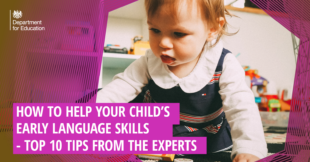
Your child’s education starts at home long before they enter the classroom. And even when they start nursery or school the home is where a significant amount of their learning happens.
That’s why it’s really important to build a positive learning environment at home – so parents can bring learning moments into their everyday activities while their child enjoys stimulating and engaging activity.
Creating an environment at home that actively encourages children to develop their language and social skills provides a great foundation for more formal learning.. And developing language skills at a young age is consistently linked with better school attainment and job prospects.
Tracy Jackson, Head of Early Years at the National Literacy Trust, and Dr Kirsten Asmussen, Head of Child Development and Early Intervention Foundation have some top tips on how you can build a great home learning environment and help your child express themselves in their earliest years:
Babies
- Make the most of the times your child is keen to copy your facial expressions – try sticking your tongue out, blinking or making lip sounds for added engagement. This also goes both ways. Copy the sounds your baby makes. Say back to them what they are trying to tell you through their noises.
- Back-and-forth conversation between parents and children increases vocabulary skills and language development. Whether they can use any words yet or not, respond to your baby’s babbling as if they are initiating a conversation. A good place to start is to notice what your baby is looking at and talk about that.
- While playing with your child, following predictable routines is important but so is an element of surprise in your playtime. ‘Body’ or ‘lap’ games that include tickling or tactile stimulation, such as ‘incy-wincy spider’ are exciting and stimulating for babies and small children.
- As your baby grows, they will start to develop ‘gesturing and joint attention’ – where they look to where you point. To encourage this key developmental stage, make lots of actions and gestures along with speech and respond to your baby's gestures – use gestures and actions to help your child understand what you say, eg saying “bye bye” and waving.
- From a very early age, a baby can recognise the difference between happy and sad faces and can copy simple facial movements. By six months, they can typically express a range of emotions such as pleasure, fear and excitement through facial expressions, vocalisations and body language. You can encourage them to express themselves by describing your baby’s emotions as you speak to them.
Young Children
- Reading with them is a key way to develop a closer connection, encouraging your child’s imagination to grow by introducing them to new words. Look at the pages together, talk about the pictures, and follow your child’s focus. Try reading to them first, and then, as your child gets older, encourage them to be more involved, first by having them turn the pages, then by discussing the story with them.
- Your little one is constantly seeing and experiencing new things, and so things like trips to thesupermarket or the shops provide a whole new world to explore. This is a chance to point new things out and name things. As soon as you notice your child looking or pointing at something, talk about it before their attention moves on to something else – that might be within a couple of seconds for babies – and this can reinforce language skills.
- Songs, poems and rhymes are enjoyed by children from a very early age. The repetition, sounds and rhythm help children to predict what’s coming next. From as early as one month, sing songs and rhymes to your baby with actions or lots of repetition. Once your child is a few years old, play rhyming games with them – can your child come up with a word that rhymes with “cat”?
- Once your baby becomes a toddler, they begin to understand what they can’t see – to be able to pretend and think about the future. Make-believe games and conversations about feelings and memories are associated with children’s vocabulary development and expressive language use. Play make-believe games together or games which use opposites such as on or off, big or little. Also encourage your child to talk about the future and anticipate events.
- Ask your child lots of questions.Use open questions with lots of possible answers. “What are you going to play with today?”, “How do you think the character will solve the problem?” Ask your child if they can give possible solutions to problems, for example if their favourite hat is missing. All this helps a child understand the past, present and future and use their memory skills.
Every child is different and there’s no one-size-fits-all. What matters most is spending time with your child chatting, playing, and reading. Every little thing you do with them will set them up well as keen little learners for when they start school.
For more information visit ‘Start for Life – chat, play, read’ where you can find tips and activities to help support your child's development and find further support in your local area.